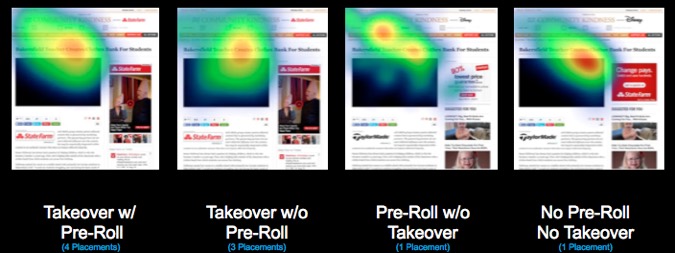-
Sticky Pioneers Eye-Tracking and Facial Coding to Discover Video Ads’ Impact
For all the billions of dollars that are now spent on online video advertising, surprisingly little is known about viewers’ reactions and engagement with specific ads, beyond core metrics like view-throughs and click-throughs. To provide far greater insights about ads’ impact, Sticky, a biometric eye-tracking analytics company, is pioneering new approaches combining eye-tracking and facial coding. Jeff Bander, Sticky’s president, recently briefed me and shared data from campaign research it conducted with AOL.
First, a little background on Sticky’s methodology and how it did the research. Sticky asks users' permission to turn on their webcams so that it can track their eye movement when looking at online content. These eye movements create a heat map of where attention was focused.
Then Sticky measures micro facial movements that give away emotional responses without any words being spoken. This process is based on techniques pioneered by Paul Ekman, a co-discoverer of micro expressions. (If you’ve ever seen world class poker players wearing sunglasses to obscure their micro expressions - the famous “tells” - this partially explains why it’s done).
Combining eye movements with these emotional measurements provides new insights on the resonance of ads. For the research, Sticky used their Sticky crowd panel and tested almost 1,500 viewers who looked at 3 different brand campaigns including video and other units. In addition to the eye-tracking/facial coding, Sticky asked participants about brand recall, likelihood to research, sponsor recall and emotional response.
Not surprisingly, when a video ad appeared on a site with other content and ad units, attention was focused on the video first. However, a State Farm ad experienced peak impact around a buffalo’s appearance rather than for the brand itself and resulted in neutral engagement and low overall impact. This contrasted with a Doritos ad where peak impact was 3 times larger and occurred twice as fast as the State Farm video.
Sticky also found wide disparities between self-reported measures of the ads’ impact vs. what was observed. Another key takeaway was the importance of pre-rolls in driving brand impact. Again, not surprisingly, a site takeover that included a pre-roll performed up to 8x better for visual branding time than takeovers without a pre-roll.
Sticky’s approach helps advertisers better understand the emotional responses to and engagement with specific campaigns and executions. Some of this feels intuitively obvious, but given how significant online video ad spending is becoming, having tools that can more precisely measure viewers’ reactions seem poised to gain in importance.Categories: Advertising, Analytics, Technology
Topics: STICKY.AD

